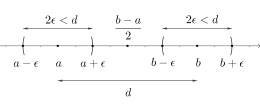Limit of a sequence
The limit of a sequence of numbers is a number to which the members of the sequence come arbitrarily close, in such a way that almost all the members of the sequence lie in each vicinity of the limit. If a sequence has such a limit, it is said to be convergent; otherwise it is said to be divergent. An example of a convergent sequence is 



The limit of a sequence is defined not only for sequences of numbers, but just as well for sequences, whose members belong to a metric space, i.e. that between them a real valued distance is defined. In a further generalization a topological space is sufficient too; there the notion of environment, which is used here, can be defined without metric too. See the sections Limit of a sequence of elements of a metric space and of a topological space.
Convergence is a fundamental concept in modern calculus. In a more general sense, it is treated in topology.
In ancient Greek philosophy and mathematics the concept of limit was not yet available, see for example Achilles and the tortoise. The modern formulation of the concept of limit value ("for every deviation, however small, there is a first index ...") first appeared in 1816 with Bernard Bolzano, later further formalized by Augustin-Louis Cauchy and Karl Weierstrass.
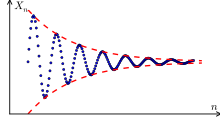
Example of a sequence that tends towards a limit value at infinity
Limit of a real number sequence
Explanation and definition
Each member 











This concretization can be well reconciled with the descriptive interpretation of convergence as "approximation to the limit": No matter how one 



The number 




Thus, this definition requires: for every ε 


This is to be understood in such a way that as ε 


Note 1: If the convergence of a sequence is to be proved with this definition, the limit value must be known in advance. However, there are also criteria with which the convergence of a sequence can be proven without the limit value being known: see convergence criteria.
Note 2: The conspicuous (by the frequency of their use) designation of "small" numbers by the letter ε 
Illustration
· 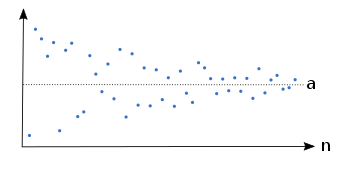
Example of a sequence 
· 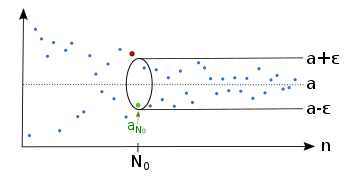
If we specify an ε 

· 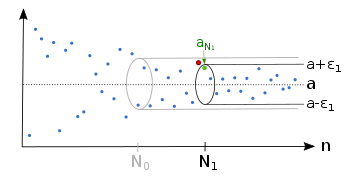
Also, for a smaller ε 

· 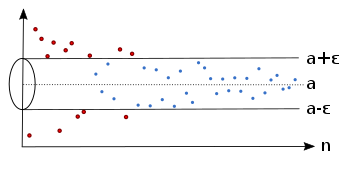
No matter which ε 

Uniqueness of the limit value
The limit of a sequence 
This statement follows directly from the definition by means of a proof of contradiction. If a sequence 













Notation
For the limit 


Besides this notation, the notation 





With this notation, the definition of the limit of a sequence can be shortened: 
Using the ambient notation, the definition is: 
Examples
The definition of the limit value is to be made clear by means of an example, after which further limit values are listed.
- To prove that the sequence
converges to , choose
as
some natural number to given ε {\displaystylewhich is greater than
(the existence of such an
is ensured by Archimedes' axiom). Then for all
:
The first inequality follows from 




Sequences that converge to zero, like this very example 
- The constant sequence
with a fixed real number
converges to
.
- The sequence
of the terminating decimal fraction expansions of
converges to
.
- The sequence
with
is convergent to Euler's number
. The sequence
converges to
. This sequence of numbers occurs in the continuous interest problem (see calculus of interest).
- The sequence
with
is not convergent, but has two convergent subsequences for even and odd
.
Calculation rules
The following calculation rules apply to limit values:
If the limit exists. 

Additionally, if 



If the values lim 

Additionally, if 



.
With the help of these calculation rules, in many cases further limit values can be easily calculated from known limit values. For example, for the limit of the sequence
Boundary value of a bounded convergent sequence
Monotonicity is not assumed for the sequences considered here.
- If a convergent sequence
real numbers has an upper bound σ
(i.e. for all
holds:
), then
.
(Indirect)Proof: Assume 



- If a convergent sequence
real numbers has a lower bound σ
(i.e. for all
holds:
), then
.
(Indirect)Proof: Assumption: 



Important limit values
for complex (and thus especially for real) numbers
.
for real
(Euler-Mascheroni constant)
Limit value formation and function evaluation
The calculation rules can be seen as a special case of the following laws:
- If
continuous at the point
and if
converges to
then

- If
continuous at the point
and if
converges to
and
converges to
, then

For continuous functions, therefore, limit value formation and function evaluation are interchangeable. The calculation rules given above thus follow directly from the continuity of addition, subtraction, multiplication and, if the denominator is not equal to zero, division.
In the real numbers, the converse also holds: if the function 





The corresponding holds for any function 







Convergence criteria
In the definition of convergence given above, the limit 
The monotonicity criterion states that a monotonically growing sequence converges exactly when it is bounded above. The limit of the sequence is then less than or equal to the upper bound. Formally, then, holds:

Similarly, a monotonically decreasing and downward bounded sequence converges.
The Cauchy criterion is based on the notion of Cauchy sequence: sequence 

The Cauchy criterion now states that a sequence in the real numbers converges exactly if it is a Cauchy sequence. This criterion plays an important role in particular in the construction of the real numbers from the rational numbers and in the extension of the notion of limit to metric spaces.
Determination of limit values
Once the convergence of a sequence is proved, the limit can be approximated in many cases by substituting a large n into the sequence and estimating the remainder. For example, for the limit 


However, there is no general procedure for the exact determination of limit values. In many cases, de l'Hospital's rule can be applied. Sometimes it is useful to convert the limit value into a certain integral. Often, however, only refined decompositions and transformations lead further.
Certain divergence
In the real numbers, we distinguish between definite divergence and indefinite divergence:
Certain divergence against 

respectively

One then writes
respectively
and says the sequence certainly diverges against 




Indeterminate divergence occurs when the sequence neither converges nor diverges determinately.
Examples
- The sequence
of natural numbers diverges determined against
.
- The sequence
diverges indefinitely.
- The sequence
diverges indefinitely.
Limit value and accumulation point
A term closely related to the limit of a sequence is the clustering point or also the clustering value of a sequence. The formal definitions differ only in the position of the existential or all-quantors:
While the limit value as
is defined, "only" the following applies to the accumulation point


Thus, the definition of limit requires that in each neighborhood of the limit, starting from a certain index, all sequence members lie; the definition of clustering point requires only that in each neighborhood infinitely many sequence members lie.
Analogous to the improper limits, the improper clustering points are occasionally defined:




Also the definition of the improper clustering point differs from the definition of the improper limit only by the position of the existential or all-quantors.
If a sequence has a proper (or improper) limit, then this limit is also a proper (or improper) cluster point. But while a sequence has at most one limit, it can have several clustering points. For each proper (or improper) clustering point there is a subsequence that converges (or diverges) against this clustering point. Conversely, if a sequence contains a convergent (or definitely divergent) subsequence, then the (proper or improper) limit of this sequence is a (proper or improper) cluster point of the sequence.
According to the theorem of Bolzano-Weierstrass every bounded real sequence contains a convergent subsequence. If the sequence is unbounded upwards, it contains a subsequence 

Illustration of the limit value of a sequence
Limit of a rational number sequence
The limit of a sequence of rational numbers is formally defined like the limit of a sequence of real numbers:
While this is 


These "gaps" were already known to Euclid in antiquity; but it was not until the 19th century that these "gaps" were successfully closed by the systematic introduction of the real numbers. A frequently used way of the systematic introduction of the real numbers is to first consider Cauchy sequences of rational numbers, to regard as equivalent those Cauchy sequences whose differences form a zero sequence, and, building on this, to define the real numbers as classes of equivalent sequences. In this extension of the number-range then the above given criterion of monotonicity and Cauchy hold; in particular that now every Cauchy-sequence is convergent.
Thus, to say whether a sequence converges, it is important to know which range of numbers is being considered; a sequence that is convergent in the real numbers may be divergent in the rational numbers. If nothing else is said, however, limit values above the real numbers are usually considered, since these are the more suitable model for most applications.
Search within the encyclopedia












![\lim _{{n\to \infty }}{\sqrt[ {n}]{n}}=1](https://www.alegsaonline.com/image/ad8399b997df7368a350c447667a7003822626e1.svg)






